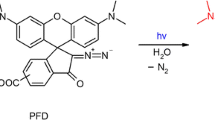Summary
Labelling of surface membrane of living ciliates: Paramecium aurelia and Tetrahymena pyriformis with fluorescent compound — cycloheptaamylose-dansyl chloride complex (CDC) has been achieved. Fluorescence micrographs of the dried samples showed specific localization of CDC on the cell membrane without any intracellular penetration. On the contrary the ciliates which have been dead during labelling revealed a non-specific fluorescence of their whole bodies. Microspectrofluorimetric analysis of labelled Paramecium cells was performed with Leitz microspectrograph. Spectrum of fluorescence emission measured over the cell membrane level had maximum at 450 nm. Strikingly, the emission maximum of the cells dead at the moment of labelling was shifted 10 nm to a longer wavelength. The rate of photofading measured in this case was almost 3-fold higher than for the ciliates labelled as living ones. Fluorescence excitation spectra did not show any difference in the peak position. Thus CDC staining appears to be an useful method of supravital labelling of cell surface enabling also to distinguish — on the basis of spectral characteristics — the ciliates being alive from those dead at the moment of fluorochrome binding.
Similar content being viewed by others
References
Berman HJ, Cassidy MA, Lee EH, Kowalczyk CJ (1975) Fluorescamine — an in vivo fluorescent tag for blood cells. Anat Rec 181:522 (Abstr)
Bottiroli G, Wyroba E, Giordano P (1981) Enhancement of fluorescence intensity of dansyl labelled Paramecium evoked by removal of surface components. Prog Protozool 6th Int Congr Protozool, Warsaw, p 36 (Abstr)
Chen RF (1967) Fluorescence of dansyl amino acids in organic solvents and protein solutions. Arch Biochem Biophys 120:609–620
Cova S, Prenna G, Mazzini G (1974) Digital microspectrofluorometry by multichannel scaling and single photon detection. Histochem J 6:279–299
Hawkes SP, Meehan TD, Bissell MJ (1976) The use of fluorescamine as a probe for labelling the outer surface of the plasma membrane. Biochem Biophys Res Commun 68:1226–1233
Hidalgo C, Ikemoto N (1977) Disposition of proteins and aminophospholipids in the sarcoplasmic reticulum membrane. J Biol Chem 252:8446–8454
Hill RJ, Zeuthen E (1980) The intrinsic fluorescence of Tetrahymena as a function of temperature. Carlsberg Res Commun 45:397–409
Kinoshita T, Iinuma F, Tsuji A (1973) Enhancement of the fluorescence intensity of dansyl amino acids in aqueous media and its application to assay of amino acids. Biochem Biophys Res Commun 51:666–671
Kinoshita T, Iinuma F, Tsuji A (1974) Fluorescent labelling of proteins and a plasma membrane using cycloheptaamylose-dansyl chloride complex. Anal Biochem 61:632–637
Nakaya K, Yabuta M, Iinuma F, Kinoshita T, Nakamura Y (1975) Fluorescent labelling of the surface proteins of erythrocyte membranes using cycloheptaamylose-fluorescamine complex. Biochem Biophys Res Commun 67:760–766
Poccia DL, Palewitz BA, Campisi J, Lyman H (1979) Fluorescence staining of living cells with fluorescamine. Protoplasma 98:91–113
Przełęcka A, Wyroba E (1973) Cytochemical studies on the surface coat of Paramecium aurelia. In: Wisse E, Daems WTh, Molenaar I, van Duijn P (eds) Electron microscopy and cytochemistry. North-Holland, Amsterdam, pp 309–312
Seiler N (1970) Use of the dansyl reaction in biochemical analysis. In: Glick D (ed) Methods of biochemical analysis, vol 18. Interscience, New York, pp 259–337
Soldo AT, Godoy GA, van Wagtendonk WJ (1966) Growth of particle-bearing and particle-free Paramecium aurelia in axenic culture. J Protozool 13:492–497
Takeichi M, Ozaki HS, Tokunaga K, Okada TS (1979) Experimental manipulation of cell surface to affect cellular recognition mechanisms. Dev Biol 70:195–205
Wyroba E (1980) Release of Paramecium immobilization antigen to the non-nutrient medium. Cell Biol Int Rep 4:1–10
Wyroba E, Przełęcka A (1973) Studies on the surface coat of Paramecium aurelia. I. Ruthenium red staining and enzyme treatment. Z Zellforsch 143:343–353
Wyroba E, Bottiroli G, Giordano P (1981a) Autofluorescence of axenically cultivated Paramecium aurelia. Acta Protozool 20:165–170
Wyroba E, Bottiroli G, Giordano P (1981b) Fluorescent labelling of surface membrane in living Paramecium aurelia. Prog Protozool 6th Int Congr Protozool, Warsaw, p 396 (Abstr)
Author information
Authors and Affiliations
Rights and permissions
About this article
Cite this article
Wyroba, E., Bottiroli, G. & Giordano, P. Cycloheptaamylose-dansyl chloride complex as a fluorescent label of surface membranes in living ciliates. Histochemistry 73, 459–467 (1981). https://doi.org/10.1007/BF00495660
Received:
Issue Date:
DOI: https://doi.org/10.1007/BF00495660




